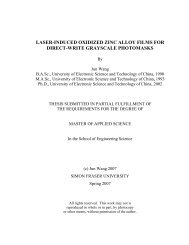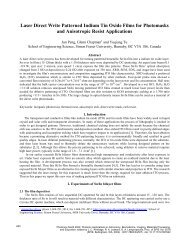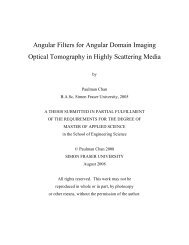Adding Grayscale Layer to Chrome Photomasks - Professor Glenn ...
Adding Grayscale Layer to Chrome Photomasks - Professor Glenn ...
Adding Grayscale Layer to Chrome Photomasks - Professor Glenn ...
Create successful ePaper yourself
Turn your PDF publications into a flip-book with our unique Google optimized e-Paper software.
3. FILM DEPOSITION<br />
The first step in creating the combined mask is <strong>to</strong> create the binary patterns on a chrome pho<strong>to</strong>mask by a<br />
conventional commercially available process. The mask was planned <strong>to</strong> contain a range of structures down <strong>to</strong> 1 µm<br />
mask size, and up <strong>to</strong> large clear areas, for a complete test of the chrome/grayscale mask. Once the binary patterns are<br />
defined the masks were shipped in sealed containers <strong>to</strong> Simon Fraser University for the grayscale bimetallic layer <strong>to</strong> be<br />
deposited on <strong>to</strong>p of the chrome pho<strong>to</strong>mask. Typically the bimetallic layer is composed of either Bi/In of Sn/In. Because<br />
Bi/In has the advantages of smoother surfaces, lower laser conversion power for grayscale levels and is able <strong>to</strong> produce<br />
more gray levels, Bi/In was chosen as the <strong>to</strong>p grayscale layer for the chrome/grayscale pho<strong>to</strong>mask.<br />
To create the Bi/In coated chrome pho<strong>to</strong>mask, bismuth and indium film of approximately 40 nm in thickness are<br />
sequentially DC-sputtered using a Corona sputtering system in Simon Fraser University’s Microfabrication Labora<strong>to</strong>ry.<br />
Both metal layers are sputtered on<strong>to</strong> the chrome pho<strong>to</strong>mask without a vacuum break. The vacuum chamber is normally<br />
pumped down <strong>to</strong> approximately 6 x 10 -7 <strong>to</strong>rr and during deposition argon gas is introduced in<strong>to</strong> the chamber at 10 sccm,<br />
bringing the sputterer chamber pressure <strong>to</strong> about 4 mTorr. Typical sputter rates for Bi and In are listed in Table 1. Note<br />
that the sputter deposition <strong>to</strong>ol was not designed for 6” masks. Film thickness control was good within the central 4”<br />
circle but was much poorer at the mask edges. Fortunately the outer edges of the mask were not used in this design.<br />
Table 1: Bi and In Sputter Rate<br />
Metal argon Pressure DC bias Current Watt⋅Min Deposit rate Å/W⋅min<br />
Bi 4mTorr 470V 0.23A 2500 12<br />
In 3mTorr 450V 0.23A 2500 4<br />
Once Bi/In deposition is completed, the Bi/In coated chrome mask is ready for grayscale patterning step. Next we<br />
discuss the mask creation process for creating grayscale patterns in this Bi/In coated chrome pho<strong>to</strong>mask.<br />
4. GRAYSCALE MASK WRITING PROCESS<br />
Having added the bimetallic film layer on <strong>to</strong>p of the chrome masks, the next step is grayscale patterning the<br />
bimetallic layer. As shown in Figure 1, the combined bimetallic-chrome mask is placed on an X-Y-Z table and<br />
positioned such that the grayscale pattern <strong>to</strong> be made would be aligned with clear alignment structures of the chrome.<br />
For alignment, the blocking and non-blocking chrome have a slight difference in height which can be seen visually on<br />
the mask through the Bi/In film. The ability <strong>to</strong> see the underlying chrome layer simplifies the process of aligning the<br />
chrome layer and the bimetallic layer <strong>to</strong> just orientating the mask correctly <strong>to</strong> match the orientation of the X-Y-Z table.<br />
A bitmap file containing the grayscale pattern is supplied and converted by a function genera<strong>to</strong>r in<strong>to</strong> voltages that<br />
are used <strong>to</strong> control an electro-optic shutter. The shutter is used <strong>to</strong> modulate the laser beam from a 488/514 nm CW argon<br />
laser as the X-Y-Z table moves the pho<strong>to</strong>mask in a raster-scan motion. As a result of this motion combined with the<br />
laser beam’s modulation, the bitmap file is patterned line-by-line on<strong>to</strong> the bimetallic film.<br />
Figure 1. <strong>Grayscale</strong> mask patterning: A bitmap file is read line-by-line (1) and converted in<strong>to</strong> a voltage waveform (2) that is used <strong>to</strong><br />
modulate the writing laser beam via an electro-optic shutter (3). The pho<strong>to</strong>mask moves in a raster-scan pattern as the focussed beam<br />
patterns the mask (4).










